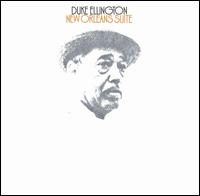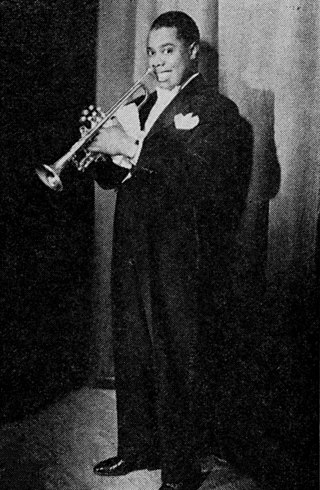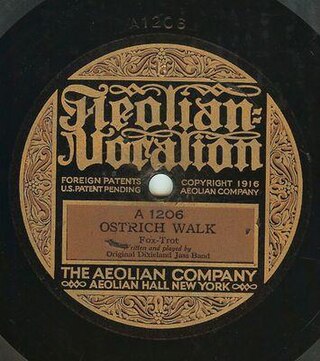The Hot Five was Louis Armstrong's first jazz recording band led under his own name.

The Mills Blue Rhythm Band was an American big band active during the 1930s.

This 1956 recording based on George Gershwin's opera Porgy and Bess was the second "complete" recording of the opera after the 1951 version, and the first recording of the work to feature jazz singers and musicians instead of operatic singers and a classical orchestra.

The Blanton–Webster Band is a compilation album that combines the master takes of all the recordings by Duke Ellington's Orchestra during the years of 1940 to 1942, involving bassist Jimmy Blanton and tenor saxophonist Ben Webster. The recordings were originally made for RCA Victor during what many critics regard as the Ellington orchestra's golden period. The three CDs contain many numbers which were to become classics, and the arrangements were frequently inventive and innovative.
"Diminuendo and Crescendo in Blue" is a jazz composition written in 1937 by Duke Ellington and recorded for the first time on May 15, 1937 by the Duke Ellington Orchestra with Wallace Jones, Cootie Williams (trumpet), Rex Stewart (cornet), Barney Bigard (clarinet), Johnny Hodges, Otto Hardwick, Laurence Brown, Joe Nanton (trombone), Harry Carney, Sonny Greer (drums), Wellmann Braud (bass), Freddie Guy (guitar), and Duke Ellington (piano). No tenor saxophone was present in this recording section, nor in "Crescendo in Blue," which was recorded the same day. In its early form, the two individual pieces, "Diminuendo in Blue" and "Crescendo in Blue," were recorded on opposite sides of a 78 rpm record. The 1956 performance at the Newport Jazz Festival revitalized Ellington's career, making newspaper headlines when seated audience members chaotically began rising to dance and stand on their chairs during Paul Gonsalves's tenor saxophone solo.
Fess Williams and his Royal Flush Orchestra was the main band of clarinetist Fess Williams from 1926–1930

Never No Lament: The Blanton-Webster Band is a 2003 three-disc compilation combining the master takes of all the recordings by Duke Ellington's Orchestra during the years of 1940 to 1942 with an additional nine tracks, including five alternative takes and four additional masters. An expanded version of The Blanton–Webster Band, this reissue, according to Allmusic, "truly worth either an initial investment or reinvestment". All About Jazz: New York observed that these performances, from what is often considered "the band in its prime", "not only set the standard for big bands and jazz orchestras, but created an ideal near insurmountable to improve upon". The Penguin Guide to Jazz selected this compilation as part of its suggested "Core Collection."

Lady Day: The Complete Billie Holiday on Columbia 1933–1944 is a 10-CD box set compiling the complete known studio master recordings, plus alternate takes, of Billie Holiday during the time period indicated, released in 2001 on Columbia/Legacy, CXK 85470. Designed like an album of 78s, the medium in which these recordings initially appeared, the 10.5" × 12" box includes 230 tracks, a 116-page booklet with extensive photos, a song list, discography, essays by Michael Brooks, Gary Giddins, and Farah Jasmine Griffin, and an insert of appreciations for Holiday from a diversity of figures including Tony Bennett, Elvis Costello, Marianne Faithfull, B.B. King, Abbey Lincoln, Jill Scott, and Lucinda Williams. At the 44th Grammy Awards on February 27, 2002, the box set won the Grammy Award for Best Historical Album of the previous year.
Sacred Concert by Duke Ellington is one of the following realisations:

New Orleans Suite is a studio album by the American pianist, composer, and bandleader Duke Ellington, recorded and released on the Atlantic label in 1970. The album contains the final recordings of longtime Ellington saxophonist Johnny Hodges, who died between the album's two recording sessions. The album won a Grammy Award in 1971 for Best Jazz Performance by a Big Band.

Duke Ellington Presents... is an album by American pianist, composer and bandleader Duke Ellington recorded for the Bethlehem label in 1956.

The Carnegie Hall Concerts: December 1944 is a live album by American pianist, composer and bandleader Duke Ellington recorded at Carnegie Hall, in New York City in 1944 and released on the Prestige label in 1977.

Studio Sessions, 1957, 1965, 1966, 1967, San Francisco, Chicago, New York is the eighth volume of The Private Collection - whereas is Volume 5 in the edition of the collection by the English KAZ Jazz Masters label - a series documenting recordings made by American pianist, composer and bandleader Duke Ellington for his personal collection which was first released on the LMR label in 1987 and later on the Saja label.

The Louis Armstrong Hot Five and Hot Seven Sessions were recorded between 1925 and 1928 by Louis Armstrong with his Hot Five and Hot Seven groups. According to the National Recording Registry, "Louis Armstrong was jazz's first great soloist and is among American music's most important and influential figures. These sessions, his solos in particular, set a standard musicians still strive to equal in their beauty and innovation." These recordings were added to the National Recording Registry in 2002, the first year of the institution's existence.

Hot Fives & Sevens is a 2000 box set collection of recordings made by American jazz trumpeter and singer Louis Armstrong with his Hot Five, Hot Seven, and other groups between 1925 and 1930. First released on JSP Records on 22 August 2000, the set was subsequently reissued on Definitive in 2001. A four-disc compilation, the set has received a "crown" as an author's pick in The Penguin Guide to Jazz and is also included in the book's "core collection" recommended for jazz fans. Allmusic concurs that it is "beyond indispensable", adding that "you can't have a Louis Armstrong collection without this historic set" or "any kind of respectable jazz collection." Alternatively, Ben Ratliff, writing in 2002, preferred Columbia's release The Complete Hot Five and Hot Seven Recordings.
"Dippermouth Blues" is a song first recorded by King Oliver's Creole Jazz Band for Gennett Records in April 1923 and for Okeh Records in June of that same year. It is most often attributed to Joe "King" Oliver, though some have argued that Louis Armstrong was in fact the composer. This is partly because "Dippermouth", in the song's title, was a nickname of Armstrong's. Also, the phonograph recordings from 1922 gave credit to Armstrong and Oliver jointly. The song is a strong example of the influence of the blues on early jazz. There is a twelve-bar blues harmonic progression, with frequent bent notes and slides into notes.

"Singin' the Blues" is a 1920 jazz composition by J. Russel Robinson, Con Conrad, Sam M. Lewis, and Joe Young. It was recorded by the Original Dixieland Jass Band in 1920 as an instrumental and released as a Victor 78 as part of a medley with "Margie". The song was released with lyrics by vocalist Aileen Stanley in 1920 on Victor. In 1927, Frank Trumbauer, Bix Beiderbecke, and Eddie Lang recorded and released the song as an Okeh 78. The Trumbauer recording is considered a jazz and pop standard, greatly contributing to Frank Trumbauer and Bix Beiderbecke's reputation and influence. It is not related to the 1956 pop song "Singing the Blues" first recorded and released by Marty Robbins in 1956.

Ostrich Walk" is a 1917 jazz composition by the Original Dixieland Jass Band released as an instrumental as an Aeolian Vocalion and a Victor 78. Frankie Trumbauer and Bix Beiderbecke recorded the song in 1927. The song is a jazz milestone as one of the first commercially released "jass" or jazz recordings.
The Chocolate Dandies was the name of several American jazz combos from 1928 through the 1940s. The name was an outgrowth of the Broadway production, The Chocolate Dandies, that debuted in 1924.

The Color Purple: Music From the Motion Picture is the soundtrack album to the film of the same name released in 1985 by Qwest Records. It consists of an original score composed by Quincy Jones and original songs performed by various artists.














